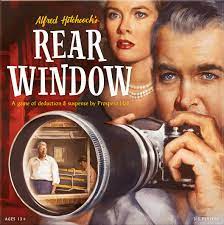Introduction:
Alfred Hitchcock’s “Rear Window,” released in 1954, stands as a timeless masterpiece that continues to captivate audiences with its suspenseful storytelling, innovative filmmaking techniques, and stellar performances. This in-depth movie review aims to delve into the intricacies of this iconic film, exploring its plot, characters, cinematography, and the enduring impact it has had on the world of cinema.
I. Plot Overview: A Glimpse into the Lives Beyond the Rear Window
- Setting the Stage: A confined Viewpoint:
- “Rear Window” unfolds within the confines of an apartment in Greenwich Village, where the protagonist, L.B. “Jeff” Jefferies, played by James Stewart, is confined to a wheelchair due to a broken leg. Jeff passes the time by observing his neighbors through the rear window of his apartment, ultimately becoming entangled in a gripping mystery.
- The Puzzling Neighbor: Lars Thorwald’s Enigma:
- The central plot revolves around Jeff’s suspicion that his neighbor, Lars Thorwald, portrayed by Raymond Burr, may have committed murder. As Jeff pieces together the puzzle from his vantage point, the audience is drawn into a suspenseful narrative that keeps them on the edge of their seats.
II. Character Dynamics: A Stellar Cast Brings Hitchcock’s Vision to Life
- James Stewart’s Compelling Performance: The Everyman in Distress:
- James Stewart’s portrayal of Jeff Jefferies is nothing short of brilliant. As an injured photographer with a penchant for observation, Stewart brings depth to the character, making the audience empathize with his predicament and root for his investigative endeavors.
- Grace Kelly’s Elegance: Lisa Fremont’s Transformation:
- Grace Kelly, who plays Lisa Fremont, Jeff’s sophisticated girlfriend, delivers a performance that transcends the stereotype of the typical Hitchcockian leading lady. As Lisa transforms from a glamorous socialite into an active participant in Jeff’s investigation, Kelly’s portrayal adds layers to the character.
- Thelma Ritter’s Stellar Support: Stella’s Wisdom:
- Thelma Ritter, in the role of Stella, Jeff’s nurse and confidante, provides invaluable support to the narrative. Her pragmatic and no-nonsense demeanor adds a touch of humor and wisdom to the story, elevating the dynamics among the characters.
III. Innovative Cinematography: A Masterclass in Visual Storytelling
- The Art of Voyeurism: Hitchcock’s Cinematic Device:
- Hitchcock employs the voyeuristic perspective of the rear window as a powerful cinematic device. By making the audience accomplices in Jeff’s voyeurism, Hitchcock blurs the lines between spectator and character, creating an immersive experience that heightens the suspense.
- Limited Set, Unlimited Impact: The Apartment Complex as a Microcosm:
- The film’s predominantly single-set location, the courtyard viewed from Jeff’s apartment, is a masterstroke. Hitchcock transforms this limited space into a microcosm of society, where each neighbor’s life becomes a subplot, contributing to the overall atmosphere of tension and intrigue.
IV. Alfred Hitchcock’s Directorial Brilliance: Crafting Suspense
- The Hitchcockian Touch: Meticulous Pacing and Tension-Building:
- Hitchcock’s directorial brilliance shines through in “Rear Window.” The meticulous pacing, strategic use of silence, and expertly crafted suspense build a palpable tension that keeps the audience engrossed from start to finish.
- Symbolism and Subtext: Layers of Meaning:
- Beyond the suspenseful plot, Hitchcock incorporates layers of symbolism and subtext. The rear window serves as a metaphor for the cinema screen, emphasizing the act of watching and being watched, a theme that resonates with the voyeuristic nature of filmmaking.
V. Legacy and Impact: Influencing Generations of Filmmakers
- Influence on Filmmaking: A Cinematic Touchstone:
- “Rear Window” has left an indelible mark on the landscape of filmmaking. Its innovative use of a limited setting, meticulous storytelling, and the exploration of voyeurism have inspired generations of filmmakers, cementing its status as a cinematic touchstone.
- Cultural Impact: Beyond the Silver Screen:
- The film’s impact extends beyond the realm of cinema, influencing popular culture and sparking discussions on ethics, privacy, and the consequences of voyeurism. Its themes remain relevant, ensuring its continued resonance with contemporary audiences.
VI. Critical Reception and Awards: Recognition of Excellence
- Acclaim and Awards: A Cinematic Triumph:
- “Rear Window” received critical acclaim upon its release and garnered several award nominations. Hitchcock’s masterful direction, the stellar performances of the cast, and the innovative cinematography were widely recognized, solidifying the film’s place in cinematic history.
- Oscar Nominations and Wins: Acknowledgment of Excellence:
- The film received four Academy Award nominations, including Best Director for Hitchcock. While it did not win in any category, the nominations underscored the film’s significance and excellence in various aspects of filmmaking.
VII. Contemporary Relevance: A Film That Stands the Test of Time
- Relevance in the Digital Age: Voyeurism and Technology:
- In the age of digital surveillance and constant connectivity, the themes of voyeurism explored in “Rear Window” resonate with contemporary audiences. The film’s exploration of the consequences of observation and the blurring of private and public spheres remains highly relevant.
- Remakes and Homages: Perpetuating the Legacy:
- The enduring legacy of “Rear Window” is evident in the numerous remakes, adaptations, and homages that pay tribute to Hitchcock’s original work. Its influence can be seen in various forms of media, reaffirming its status as a cultural touchstone.
VIII. Conclusion: Rear Window’s Ever-Open Perspective
In conclusion, “Rear Window” (1954) is a cinematic gem that transcends time, weaving a narrative of suspense, intrigue, and social commentary. Hitchcock’s directorial genius, coupled with stellar performances from the cast, creates a film that invites viewers into a world of voyeurism and moral ambiguity. As the rear window remains ever-open, inviting audiences to peer into the lives of its characters, the film stands as a testament to the enduring power of storytelling and the art of filmmaking. “Rear Window” remains not just a classic of its era but a timeless exploration of the human condition through the lens of a rear window.
